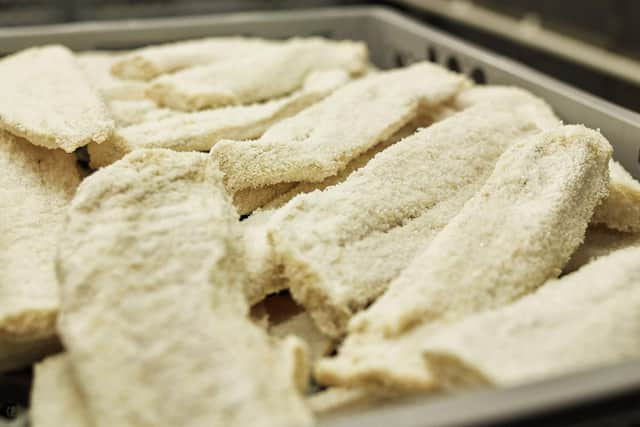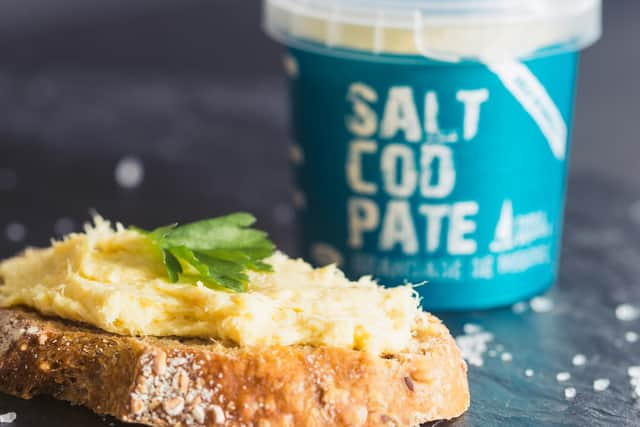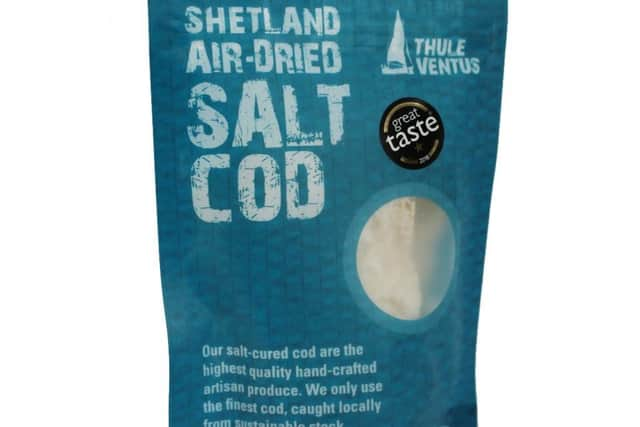Thule Ventus are bringing back salt cod done the traditional Shetland way
In Portugal, they know it as bacalhau, the Basque Country call it bacalao, and in Norway, it’s klippfisk.
Saltfish is served with ackee in Jamaica, and they batter and fry it in Greece to make bakaliaros. There are endless variations worldwide and, throughout history, this preserved fish has been a delicacy as well as something to subsist on.
Advertisement
Hide AdAdvertisement
Hide AdHere in Scotland, it’s a lesser-known speciality, though in Shetland, they’ve been salting cod to preserve it, as well as mutton, in the case of reestit mutton, and beef, for saat beef, across generations for centuries.


Not so much these days, until the advent of business Thule Ventus.
Its owner, David Polson, 49, lives with his partner Liz Clarke, who works as a nurse, and two daughters in Cunningsburgh, in the south mainland of Shetland. He grew up on the salted cod his father, who worked as a joiner and built houses, would make, using leftover fish from that day’s catch.
“We had a croft with 18 to 20 sheep and a small wooden boat,” he says.
"The traditional island life. We’d go off and catch fish over summer if it was a nice weather. Then we'd take it home and have it for supper before salting whatever was left over, whether it was whiting, herring, pollock or coley. It was a traditional thing.”


After he grew up, Mr Polson almost forgot about this activity, until he went down south.
“Probably 15 years ago, when my sister was nursing in London, I'd go down and visit,” he says. “She stayed in Crouch End and you'd have to walk to the tube station where there are a lot of African and Caribbean shops. That's where I noticed a lot of the salt fish and dried fish in boxes. I went home, got some cod and salted it.”
It tasted as he remembered, back when his father made it, and Mr Polson thought there might be something in recreating and selling this dish from his childhood.
Advertisement
Hide AdAdvertisement
Hide AdHe took his creation along to a few local restaurants, but the idea didn’t really take off. However, it still planted the seed for the future business and eight years ago Mr Polson decided to pick it up again.


He says: “You could see that the internet was in a better place, farm shops were developing and this foodie heritage culture was starting to take off. So I thought I would try again and take it a bit more seriously this time.”
Mr Polson decided to operate the business on the side of his full-time gig as a manager at a shipping company, Johnson Marine. He’d already come up with the name, Thule Ventus, though it was originally going to be used for another project – a wind turbine, which would be used to create oxygen for the aquaculture industry.
Thule is the Roman name for Shetland (or the North) and ventus is Latin for wind. As he says, “it sort of fitted for salt cod too”.
Now the website sells their Shetland Air-Dried Salt Cod, which bagged a Great Taste Awards star in 2019 and has featured in James Martin’s cookbook Islands to Highlands, where it is an ingredient in a salted cod and piltock dish with tomato ragout.


This Marine Stewardship Council-accredited product is made using as traditional a method as possible. When salt cod production and export was a big industry in Shetland, they used to dry it on the beaches, and school children would be tasked with bringing the fish in if it started to rain, then putting it out again whenever it stopped.
The process has been slightly modernised. These days, health regulations won’t allow him to dry it outside and Mr Polton has to do most of the labour himself, without the use of local schoolkids. The rest of the method can’t be rushed.
After filleting the cod, which is sourced from Lerwick and Scalloway fish markets, he salts it and leaves it for two to three weeks, sometimes up to a month, then he takes over the work the wind and sunshine would once do, replacing the natural elements with dehumidifiers, lights and fans, to dry it out.
Advertisement
Hide AdAdvertisement
Hide AdThere’s a delicate balance, so the fish doesn’t go too soggy or veer into jerky leather territory. The process takes around two months to complete.
Although this is their signature product, a recent success has involved using it as an ingredient in their Salt Cod Pate or Brandade de Moreau, with Thule Ventus’s take on the French delicacy featuring Shetland buttermilk and Ola Oils Rapeseed Oil, garlic, lemon and lime.
“It’s a variation on a classic recipe for a brandade, which would have been made by the peasant farmers of Provence,” Mr Polson says. “They would have made it in the morning and put it on their toast at lunch. That's the traditional way of having it.”
Mr Polson’s youngest daughter is the ultimate ambassador for this pate, as she eats it like it’s “going out of fashion”, though his eldest refuses fish of any variety.
Although his offspring may have worked their way through most of their stock, this product still managed to win Small Producer Fish and Platinum Small Producer prizes at the 2021 Scottish Retail Food and Drink Awards.
They’ve also diversified into traditional Bacalao Wet Salt Cod, Catch of the Day Fish Subscription Boxes, Shetland Air-Dried Salt Piltock – a traditional Shetland creation, made from coley rather than cod – as well as dog treats made from cod skin – a by-product, as the Shetland Air-Dried Cod uses all the best parts of the fish.
For those who want to try the salt cod, it needs to be treated appropriately. Before use, the white fish has to be soaked in water for 12 to 24 hours to draw out the salt, with the liquid being changed once or twice in that time. Once it’s been prepared, the salt cod is delicately flavoured and creamy textured.
“There's a bit of forethought that's needed,” Mr Polson says. “The actual cooking process is nice and simple, but you have to think about it a day or so in advance, so you have time to soak it and prepare it.”
Advertisement
Hide AdAdvertisement
Hide AdAlthough he sells his products almost entirely in the UK, most of his customers are from countries where salt cod is part of their food culture, though others are experimenting with it for the first time.
“I always say there's a 50/50 mix, with half of my customers knowing what they're getting,” he says.
"It's either Spanish, Portuguese or Brazilian people living in the UK, some from Eastern Europe, Scandinavia and those from Scotland who’ve grown up on salt fish. Portugal and Spain have a big salt fish culture, so they’re a large proportion of my customer base.
"The others are people who want to explore and try foods that are new to them. It's growing steadily in popularity, but it's kind of a slow education going from fresh fish to a salt fish.”
The most obvious dishes that people make from the Shetland Air-Dried Cod are fishcakes or croquettes.
“They get out the deep fat fryer,” says Mr Polson. “It’s a very broad spectrum of cooking, and goes from those options to quite sophisticated Spanish and Portuguese dishes with a lot of tomatoes, red and green peppers, onions, garlic and white wine”.
Mr Polson very much markets the product as a delicacy, at £7.79 for an 80g bag.
“You have to go to the very highest end of the market, because nothing else makes any financial sense,” he says.
Advertisement
Hide AdAdvertisement
Hide AdThis is because he uses the prime parts of the cod. The actual process of making this produce takes weeks and the protein shrinks as the salt draws out the moisture.
He ends up with less than he put in, thus it was never going to be an easy buck. However, Mr Polson hopes customers will appreciate the labour and thought that’s gone into his creation.
As he says: “We need to work on education and take the fear out of the product, because it’s something that kept people alive for hundreds of years.”
A message from the Editor:
Thank you for reading this article. We're more reliant on your support than ever as the shift in consumer habits brought about by coronavirus impacts our advertisers.
If you haven't already, please consider supporting our trusted, fact-checked journalism by taking out a digital subscription.
Comments
Want to join the conversation? Please or to comment on this article.